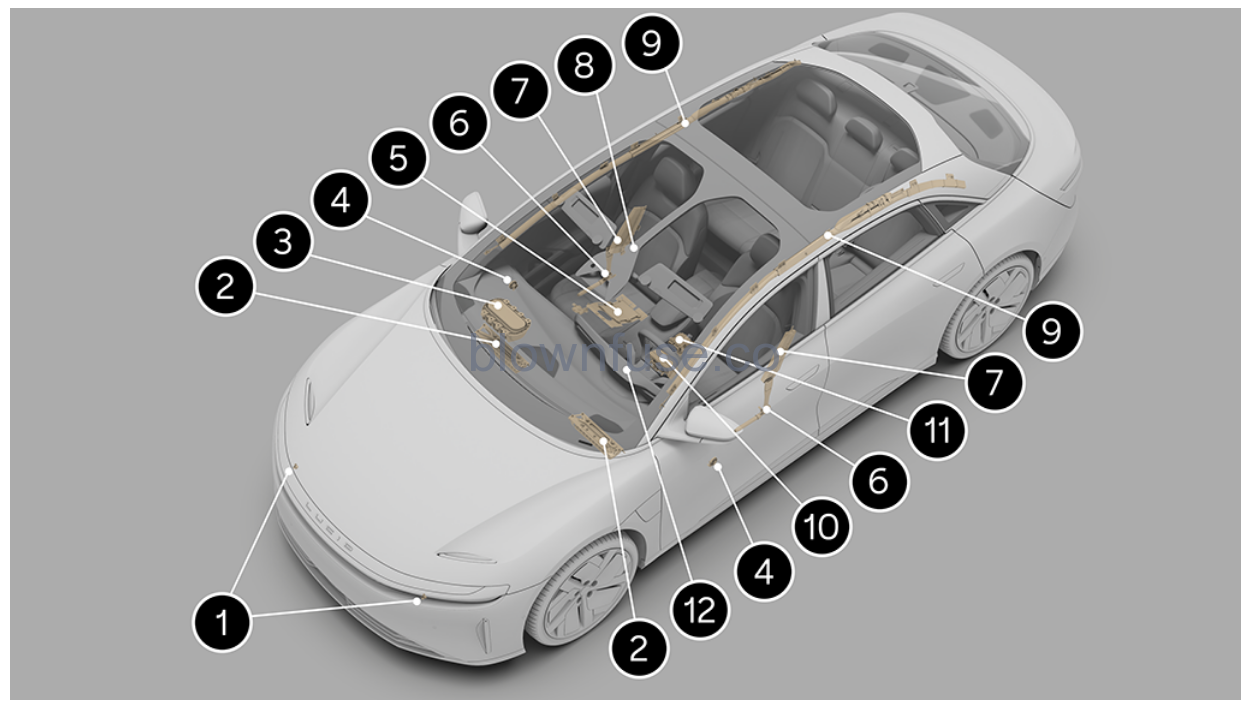2022 Lucid Air Airbags Owners Manual




2022 Lucid Air Airbags


Location of Airbags and Airbag Sensors


- Front-impact sensors
- Knee airbag
- Front passenger’s airbag
- Side impact sensor (front door)
- Passenger seat OCS sensor
- Front seat belt pre-tensioner
- Side airbags (seat-mounted)
- Passenger airbag status indicator (overhead console)
- Curtain airbag
- Driver’s airbag
- Airbag control module
- Airbag SRS warning indicator
NOTE: The illustration shows approximate airbag locations.
Airbag Safety Information
- WARNING: Even with airbags, the driver and occupants must always wear their seat belts to minimize the risk of severe injury or death in the event of a collision.
- WARNING: Do not attach or place objects on or near the front airbags, the side of the front seats, the headliner at the side of the vehicle, or any other location that could interfere with the inflation of an airbag. Objects can cause serious injury if the vehicle is in a collision severe enough to cause the airbag to deploy.
- WARNING: For the curtain airbags to deploy correctly, the roof lining and A-post trim must be undamaged and installed correctly. Any damage or suspect installation should be referred to a Lucid Service Center for inspection.
- WARNING: Front-seat occupants should not place any part of their arms, body against the steering wheel or dashboard area, as an inflating airbag can cause fractures or other injuries.
- WARNING: Do not use seat covers in the vehicle. A seat cover could interfere with the deployment of the seat-mounted side airbags in the event of a collision.
- WARNING: Airbags inflate with considerable speed and force. To reduce the risk of injuries, ensure that all occupants are wearing seat belts and are correctly seated, with seats positioned as far back from any front airbags as possible.
- WARNING: Never use a child safety seat or seat young children on a seat with an operational airbag in front of it. Doing so can cause serious injury or death if the airbag deploys.
- WARNING: To ensure correct inflation of the side airbags, maintain an unobstructed gap between an occupant’s torso and the side of the vehicle.
- WARNING: Occupants should not lean their heads against doors. Doing so can cause injury if a curtain airbag deploys.
- WARNING: Do not allow occupants to obstruct the operation of an airbag by placing feet, knees, or any other part of the body on or near an airbag
- WARNING: Contact Lucid first if you are planning to modify your vehicle for a person with disabilities in a way that may affect the airbag svstem. See Contacting Lucid Motors.
Airbag Safety Labels
Airbag safety labels are on the sun visors for the driver and front passenger.
How the Airbags Work
- WARNING: The airbags are a Supplemental Restraint System, providing additional protection in certain types of collisions only; they do not replace the need to wear a seat belt.
- WARNING: Occupants not properly restrained in designated seating positions are at high risk of death or serious injury in the event of airbag deployment.
- WARNING: Do not use a child restraint on a seat with an operational airbag in front of it. There is a risk of death or serious injury if the airbag deploys.
Airbags inflate when sensors detect an impact that exceeds deployment thresholds. These thresholds are designed to predict the severity of a crash in time for the airbags to help protect the vehicle’s occupants.
Airbags inflate instantly and with considerable force, accompanied by a loud noise. The inflated airbag and the worn seat belts limit the occupants’ movement to reduce the risk of injury.
The front airbags are not designed to inflate as a result of:
- Rear collisions
- Vehicle rollover
- Slow-speed front impacts
- Side impacts
- Driving over bumps or potholes
Therefore, significant superficial damage can occur to the vehicle without the airbags inflating or, conversely, a relatively small amount of not easily visualized structural damage can cause airbags to inflate. Heavy braking.
Types of Airbags
Front airbags
The front airbags are designed to protect the head and chest of the driver and front passenger from impact with the steering wheel and dashboard panel components. The front airbags fitted to your vehicle are advanced airbags. This type of airbag is designed to reduce airbag-related injuries to children or small-statured adults. Your vehicle has front seat position sensors. These sensors help make sure that the airbag inflates wth less force if the seat is closer to the airbag than if the seat was further away, regardless of the impact severity. An occupancy sensor is built into the front passenger seat. If the sensor detects the weight of an infant or small child, the system will automatically turn off the passenger’s front airbag. However, Lucid does not recommend that you seat an infant or small child in the front passenger seat. See Guidelines for Seating Children. No objects should be placed over or near the airbag on the instrument panel because the object could cause harm if the vehicle is in a crash.
NOTE: If there is no front seat passenger detected, the passenger front airbag will not activate. See Front Passenger Seat Occupant Classification System (OCS).
Side airbags
- WARNING: Maintain a gap between the side of the vehicle and the torso; this enables correct inflation of the seat-mounted side airbags.
- WARNING: Do not use seat covers or accessory seat covers on a front seat, as these will prevent the side airbag from deploying correctly in an accident. If in doubt, contact a Lucid Service Center.
- WARNING: Lucid recommends a Lucid Service Center performs all repairs. Incorrectly performed repairs to the side airbag system could impair function and lead to serious injury or death.
The side airbags are designed to protect the thorax region of the torso and pelvis and only deploys in the event of a severe side impact. They do not inflate as a result of frontal or rear impacts only. The airbags on the non-impacted side of the vehicle do not deploy.
Knee airbags
The knee airbags are designed to work in conjunction with the deployment of the front airbags. When deployed, the knee airbags limit the forward motion of the driver or front passenger by restricting leg movement, thereby positioning the occupant so that the front airbags work more effectively.
Curtain airbags
WARNING: Make sure that passengers do not lean their heads against the doors. In the event of a collision, the curtain airbag deploys from the headliner and may cause injury.
WARNING: Never hang or attach heavy objects from the grab handles on the headliner. The hooks are for lightweight garments (not for hard objects).
The curtain airbags are designed to protect the head in severe frontal crashes with a lateral component, severe side impacts, or rollovers. They do not inflate in all frontal impacts and do not inflate alone in a rear impact.
Obstruction of Airbags
- WARNING: Do not allow passengers to obstruct the operation of the airbags by placing feet, knees, any other part of the body, or any other objects in contact with, or in close proximity to, an airbag module.
- WARNING: Do not attach or position items on an airbag cover that could interfere with the inflation of the airbag or be propelled inside your vehicle and injure occupants.
- WARNING: Never place your arm over an airbag cover. A deploying airbag can cause serious fractures or other injuries.
For the airbags to correctly deploy, obstructions cannot intervene between an airbag and the Occupant.
The following are examples of the type of obstructions that could impede the correct operation of the airbags or jeopardize personal safety in the event of an airbag deployment:
- Accessories attached to or obscuring an airbag cover (for example, attached to the roof lining, door pillar trim, or the front seat backrests)
- Items of hand luggage, or other objects placed on an airbag cover
- Feet, knees, or any other part of the anatomy in contact with, or in close proximity to, an airbag cver
- Head, arms, or any part of the anatomy in contact with, or in close proximity to, a seat- mounted side airbag
- Objects (such as items of clothing) hanging from the handles attached to the headliner
- Objects (such as items of clothing or cushions) draped over the part of the front seat containing the airbag
- Seat covers/accessory seat covers over a front seat; in particular, seat covers that have not been designed for use with seat-mounted side airbags. If in doubt, consult your Lucid Service Center.
Front Passenger Seat Occupant Classification System (OCS)
- WARNING: Lucid strongly advises against seating a child on the front passenger seat, even if the passenger airbag is Off. All occupants age 12 and under should ride in the rear seats. See Child Safety Locks.
- WARNING: The full weight of the front seat passenger should always be directly on the seat cushion. Passengers should never lift themselves off the seat cushion by using the armrest in the door or the center console, by pressing their feet on the floor, by sitting on the edge of the seat cushion, or by pressing against the backrest in a way that reduces pressure on the seat cushion. The passenger should never place anything (such as a cushion) between themselves and the seat that could cause OCS to disable the front passenger’s airbag.
Deployment of the front passenger airbag is not always beneficial for small or lower-weight occupants and could be harmful to children/infants in restraint systems. The front passenger seat is fitted with an occupancy sensor that controls the status of the front passenger airbag based on the weight of the occupant.
NOTE: The occupancy sensor system only controls the deployment of the front passenger airbags and passenger side airbags. It does not affect the deployment of the seat belt pre-tensioner or the passenger curtain airbag.
The occupancy sensor system meets the regulatory requirement of FMVSS 208 and automatically detects when deployment of the front passenger airbag may be unnecessary or potentially harmful.
A status message on the overhead console indicates whether the front passenger airbag is currently OFF.
You should always check whether the passenger airbag status indicator shows the correct status for the current seat occupancy.
If you think the passenger airbag status is incorrect, check for the following:
- Objects lodged underneath the seat
- Objects wedged between the seat cushion and the center console
- Objects hanging off the back off the seat
- Cargo interference with the seat
- Rear-seat passengers pushing or pulling on the front passenger seat
Any of the conditions listed above may cause the occupancy sensor to incorrectly interpret the weight of the occupant or object as either heavier or lighter than the real weight.
Depending on the input received from the occupancy sensor, the passenger airbag status indicator operates as follows:
- A low-weight object or occupant is classified as weighing less than 52 lb (23.5 kg). The movement of a low-weight occupant or object while your vehicle is in motion may cause the status indicator to switch states occasionally.
- Never install a rear-facing child restraint system on the front passenger seat. A forward-facing child restraint system should only be installed on the front passenger seat when it is unavoidable.
- For some children (a child in a seat, booster seat, or convertible seat), the system may not recognize them as a child. Factors that may affect this can be the physique or posture.
- The system judges a person of adult size as an adult. When a smaller adult sits in the front passenger seat, the system may not recognize them as adults, depending on their physique and
NOTE: It is possible to receive an intermittent indicator status with an empty seat. This is part of the system’s behavior and it does not affect the status of the front passenger airbags. However, it the status indicator is not permanently illuminated when the seat is empty, contact a Lucid Service Center immediately.
If you still believe that the airbag status indicator is incorrect, have your passenger ride in the rear of the vehicle and contact a Lucid Service Center to have the system checked.
Front passenger seat OCS precautions
WARNING: Failure to observe the following precautions regarding the front passenger OCS may cause death or serious injury.
- Wear the seat belt properly. See Wearing Seat Belts.
- Make sure the front passenger’s seat belt latch plate is not inserted into the buckle before someone sits in the front passenger seat.
- If an adult is seated in the front passenger seat, and the PASS AIR BAG OFF indicator is displayed, ask the passenger to sit up straight, well back in the seat, with feet on the floor, and with the seat belt worn correctly. If the PASS AIR BAG OFF indicator remains displayed, ask the passenger to move to a rear seat or move the front passenger seat fully rearward. In either case, contact a Lucid Service Center to help corect the issue.
- Child restraint systems installed on the rear seat should not contact the front passenger seat back.
- Do not recline the front passenger seat back so far that it contacts a rear seat or an object in the rear of the vehicle. This may cause the PASS AIR BAG OFF indicator to be displayed. Return the seat back to a position where it does not touch the seat or object. Keep the front passenger seat back as upright as possible when the vehicle is moving. Reclining the seat back may lessen the effectiveness of the seat belt system.
- Make sure the PASS AIR BAG OFF indicator is not displayed when using a seat belt extender for the front passenger. If the PASS AIR BAG OFF indicator is displayed, disconnect the latch plate from the seat belt buckle and reconnect the seat belt. If you continue to use the seat belt extender while the PASS AIR BAG OFF indicator is displayed, the airbags for the front passenger will not activate correctly. This could cause death or serious injury in the event of a collision.
- Do not apply a heavy load to the front passenger seat.
- Do not put objects underneath the front passenger seat.
- Do not allow rear seat passengers to put weight on the front passenger seat by putting their hands or feet on the seat back.
- Do not let a rear passenger lift the front passenger seat with their feet or press on the seat back with their legs.
- Do not allow a passenger to kick the front passenger seat or subject it to a severe impact. This could cause the Airbag SRS warning indicator to be displayed and prevent the system from operating correctly in an impact. Contact a Lucid Service Center if the warning indicator is displayed.
- Do not modify or remove the front seats.
Effects of Airbag Inflation
WARNING: When airbags deploy, a fine powder is normally released. This powder can cause irritation. Thoroughly flush the power from the eyes and skin, including any cuts or abrasions. The powder may aggravate asthma for some people.
WARNING: The following inflation, some airbag components are hot. Do not touch them until they have cooled.
After inflation, the airbags deflate to provide a gradual cushioning effect, and also to clear the driver’s field of vision.
If airbags inflate or your vehicle has been in a collision, always have the airbags, seat belt, and all associated components checked and (if necessary) replaced by Lucid.
Safety features
Along with the inflation of the airbags, the following also occurs to assist you and any recovery personnel:
- Doors unlock
- Hazard warning lights turn on
- Interior lights turn on
- High-voltage power is isolated
Airbag SRS warning indicator
You will be alerted of an airbag system malfunction with a red warning indicator on the Cockpit Panel.
The components monitored by the system include:
- Airbag modules
- Seat belt pre-tensioners
- Airbag diagnostic control unit
- Crash sensors
- Airbag wiring harnesses
- Seat occupancy sensors
- Seat belt buckle sensors
When the vehicle is On, the airbag control unit monitors the readiness of the system’s electrical circuits.
You should contact a Lucid Service Center if the warning indicator:
- Fails to illuminate when the vehicle starts.
- Fails to extinguish within approximately 6 seconds after the vehicle starts.
- illuminates while driving the vehicle.
Airbag Service Information
- WARNING: Do not attempt to service, repair, replace, or modify any part of the airbag system. This includes wiring or components in the vicinity of the airbag components. Doing so may cause the system to trigger or render the system inoperative, either of which may result in death or serious injury.
- WARNING: Any notable damage to airbag components or covers (for example, tears, burns, holes, chemical or detergent damage, or previous accidental damage), however produced, may cause the airbag module(s) to fail. Make sure a Lucid Service Center repairs or replaces any damaged components.
- WARNING: If you need to dispose of an airbag or seat belt pre-tensioner, contact a Lucid Service Center. Incorrect disposal procedures could cause personal injury.
Recent Posts
VW Jetta Engine Fuse Box Diagram
Access the comprehensive 2010-2018 VW Jetta Passenger Fuse Box Diagram to troubleshoot electrical issues effectively.…
VW Jetta Passenger Fuse Box Diagram
Explore the comprehensive VW Jetta Passenger Fuse Box Diagram to troubleshoot electrical issues effectively. Understand…
2023 Ford F-150 Lightning Fuse Box Diagram
Under Hood Fuse Box Location Remove the front luggage compartment cover. Under Hood Fuse Box…
2022 Kawasaki NINJA H2 SX SE Brake Lever Adjuster Owner’s Manual
2022 Kawasaki NINJA H2 SX SE Brake Lever Adjuster Owner's Manual NOTICE Only adjust the front…
2023 Land Rover Range Rover Evoque Exiting The Vehicle Owners Manual
2023 Land Rover Range Rover Evoque Exiting The Vehicle SINGLE LOCKING WARNING Before exiting the…
2023 Land Rover Range Rover Evoque Front Seats Owners Manual
2023 Land Rover Range Rover Evoque Front Seats FRONT SEAT SAFETY Make sure to read…
